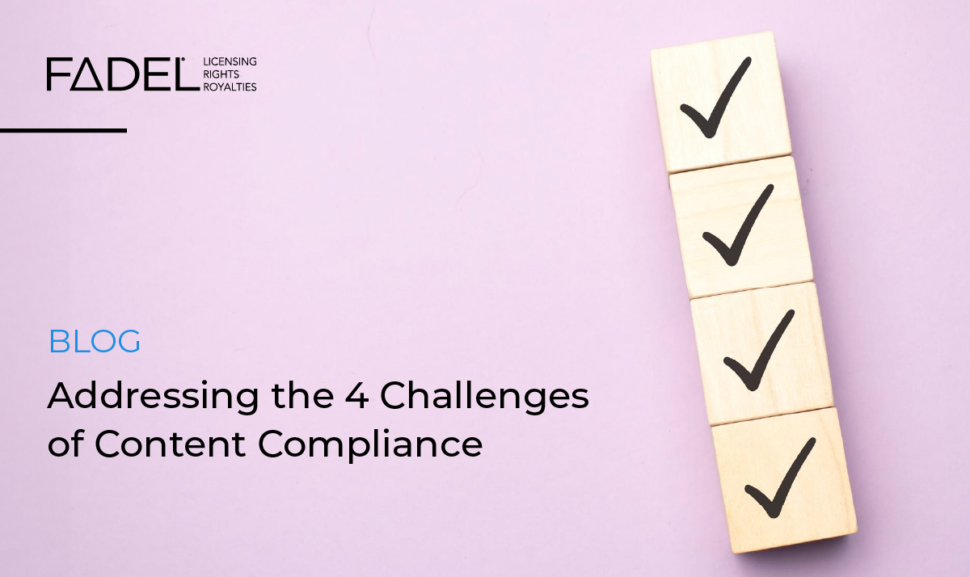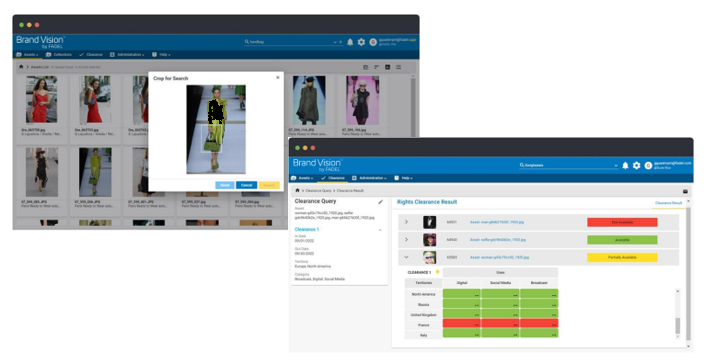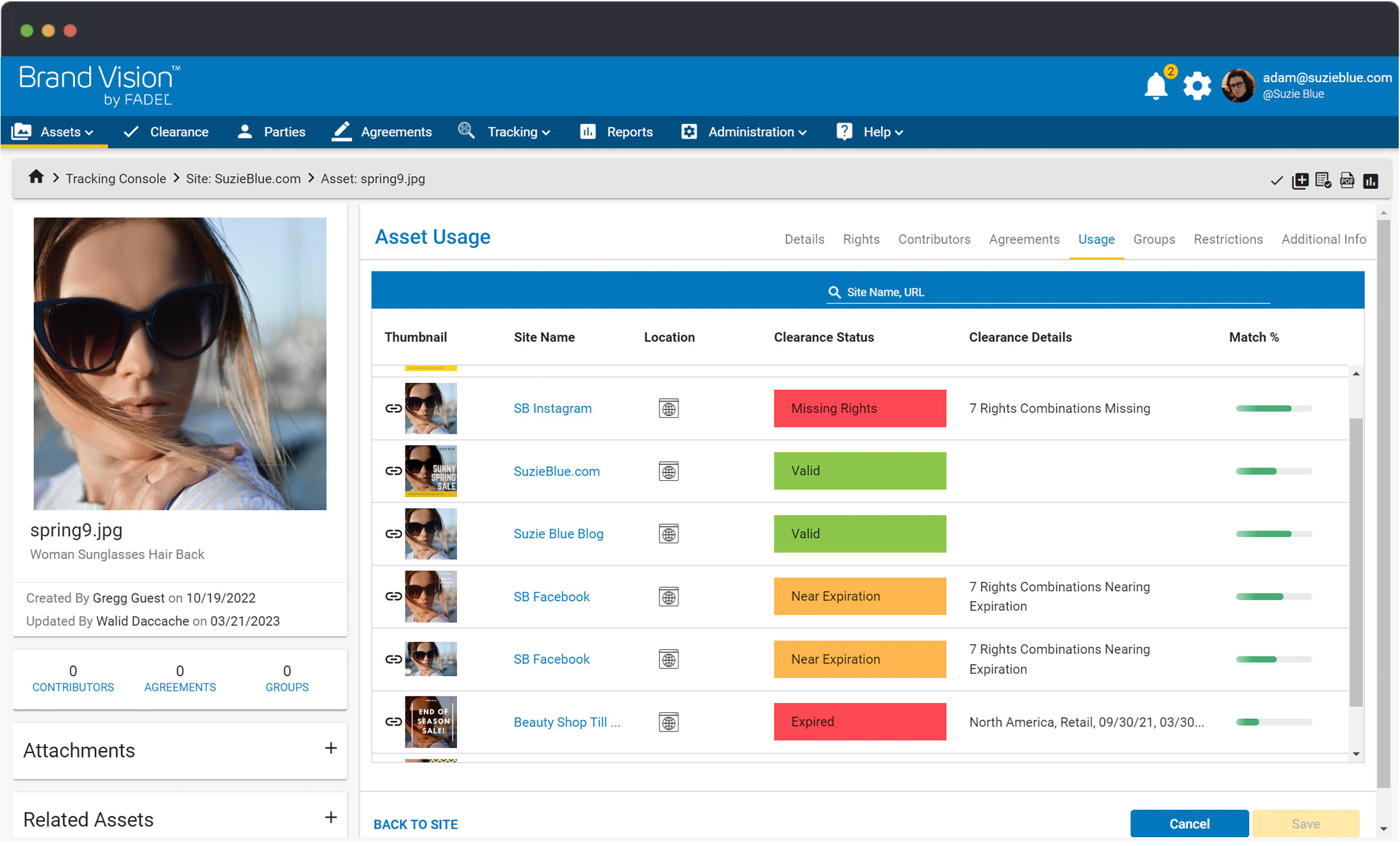
Keeping a Watchful Eye on
Your Digital Footprint with Digital Content Tracking
See Content Tracking in Action
What is Digital Content Tracking?
Content tracking enables brands to track their digital fingerprint, while giving insightful feedback into their content’s reach and usage.
In recent times, we’ve seen a surge of digitization of just about anything, including marketing content and tactics. As information circulates the web, it becomes more accessible but also complicates things.
Digital marketing has become vital to getting your content visible to consumers who are bombarded with competitors doing the same. So as more and more content floats around the web, how does tracking come into play?
Often overlooked, digital content tracking is quickly becoming an essential concept for content creators in the marketing and advertising world. It is essentially the act of keeping tabs on your digital content post-production and post-distribution. Tracking comes in various forms, with marketers seeking different types of intelligence such as:
- finding and identifying content (eg – photos, ads, logos, packaging, videos, reels)
- monitoring their brand presence
- measuring content performance (eg – clicks, impressions, shares)
- looking for violations such as expirations, misuse or even theft

Marketing Is Getting Complicated
Omni-channel marketing in which brands are able to market themselves over an expanse of mediums, both physical and digital, certainly has made marketing strategies and content strategies more complex. Being able to reach a larger audience with cohesive brand messaging by distributing and reusing the same digital assets is ideal but offers a bigger challenge in keeping up with all of the digital content put out.
How do you do effective marketing? As VP of Industry Relations at Silverpop Loren McDonald said, “it means listening to and capturing data and behavior from a customer across all channels…” So, gaining insights to improve customer experience is integral – but how to do that? Answer: Tracking.
As part of that tracking, the content must be monitored in order to ensure that the brand is optimally represented on all platforms so as to keep a unified brand identity. With so many channels to market content on, it is imperative that brands become smarter by gathering information on how they’re being perceived online.
How Does Content Tracking Work?
There are various approaches for content tracking depending on your goals:
- Identifying Content across Designated Sites – It may be easy to find and manage your content across your own brand sites and social sites, but often sites where you intentionally publish content to are managed by different entities or software. For example you may provide content to your e-commerce partners or you may have an agency managing your social presence and your internal team managing your brand sites. Finding your content post-distribution can be a real headache. Solutions may include tools for web crawling based on image and video recognition while other tools use a digital watermark.
- Identifying Content across the Internet – If you need to go beyond a defined list of sites that you publish to then you are probably looking for theft. The solutions include the same types of tools for image recognition or digital watermarking but not all tools can search across social sites or photo sites such as Facebook, Instagram, Flickr, etc.
- Measuring Content Performance – Running a tracking pixel on a specific webpage, tracks impressions and number of clicks giving you more specific metrics into how your product/campaign is doing
- Content Compliance – If you are able to find your content the next question is whether it is valid. In other words, does it meet brand compliance usage compliance guidelines? There are some tools that can pair finding/tracking with a compliance check such as alerting to expired content or content that is being used on a site or in a geography that you don’t have the rights to.

What is Content Identification?
“Identification” is simply “finding.” It is getting organized to know what you have out there, especially as your brand grows and you distribute more content. The last thing anyone wants is content, with probable expiration dates, getting ‘lost’ on the internet where anyone can see it. Monitoring content is an integral, yet tedious task that should not be taken lightly in the omni-channel marketers scheme prevalent in today’s business practices. There is simply too much information floating around to not have a clear and organized strategy.
How? Many of the solutions fall into these categories:
- Reverse Imaging Technology – This technology takes an image and analyzes the pixels for key visual characteristics that make them “findable” across the internet. There are some free options, good for one off searches, such as Google Reverse Image, Google Cloud Vision and TinEye. There are also the more user-friendly tools designed for marketers – such as FADEL’s Brand Vision – Content Tracking Software – that will find all public images and videos across designated sites and then automatically match those against your own content storage or DAM. Paired with web crawlers, searches will be conducted across websites, social sites and e-commerce sites. These are good for volume searches and monitoring, ease of use and reporting.
- Digital Watermarking – Another paid option is to digitally watermark your images through a vendor or service. These are physical yet invisible markings that are then traced by the vendor’s bots that crawl the web to pick them up. These however don’t typically find images across social media platforms such as Facebook, Twitter, Instagram and others so are better for general internet site searches.
- Content Syndication – Many systems will syndicate content on your behalf such as PIMs and social media platforms. They may track the content that they push out, however specific to the platforms or targets that they manage so less of a consolidated view across all usage.
Measuring Content Performance
You published content. You found your content. Now what? The more information intelligence you can obtain, the better job you can do in marketing effectively. “Content marketing measurement isn’t a one-time effort, it’s an ongoing process,” says Jodi Harris, Road Map to Success: Monitoring and Measuring Your Content’s Performance.
Let’s look at a sports drink company. They have created three different advertisements for their newest drink flavor. Each advertisement follows a different theme and features different celebrities. Post-creation, the company distributes all three options to various affiliates who then choose which one to advertise on their platform.
By tracking their content post-creation, the company is able to monitor the popularity of their advertisements, seeing which of the three has a broader reach and is being used more often. This is helpful in understanding how retail partners, and their customers, react to advertisements and what attracts attention.

What is Content Compliance?
Content compliance can be to ensure brand compliance and/or rights compliance. Is the correct logo, font and packaging “live” in your digital footprint? Has the content expired? Is any of the content being used where it is not allowed?
Going back to the sports drink example. The three advertisements distributed to various affiliates reflected the ‘new’ product of the year. After a year, for example, the drink is no longer new; having an advertisement that describes the product as ‘new’ rather than what it really is reflects negatively on the brand.
Let’s also say that the bottle and label packaging has changed for our sports drink and your creative agency has updated the advertisements to replace the old packaging with the new one. To maintain brand compliance, it is important to identify where the ads are published even across your retail partners and have them make the updates.
Expired Rights & Licenses are Bad News
The other side to these ‘old’ advertisements is the rights violations and expirations associated to the talent used in them. Back one more time to our sports drink campaign. The ads each have a model and photographer contracted to the creation of it, each talent licensing a specific time period and geographical boundary to where/how/when their content can be used.
If the model’s contract expired as well as the rights to all related advertisements you have to now manage a takedown process across brand sites, social sites as well as external sites not managed by your teams. If the takedown doesn’t happen or an ad is being mistakenly misused on the wrong platform, the sports company is liable to lawsuits by the talent who only gave rights for a certain period and place.
Being compliant on all platforms helps build and maintain a good brand reputation as well as keeps you organized on where your content is being used properly and improperly. By staying informed and up to date, brands save themselves time and money on legal issues as well as management of the multitudes of rights associated with content being distributed on multiple platforms. If each piece of digital content distributed has different terms for different platforms, the margin for human error will widen and open a brand up for a higher chance of legal trouble.
5 Things to Look for in Content Tracking Solutions
Rights management
Visual search
Content tracking
Monitoring capabilities
Reporting
To learn first-hand how FADEL Brand Vision – Content Tracking combines digital content tracking across designated sites with content compliance for expirations and rights you can request a 30-day free trial.














